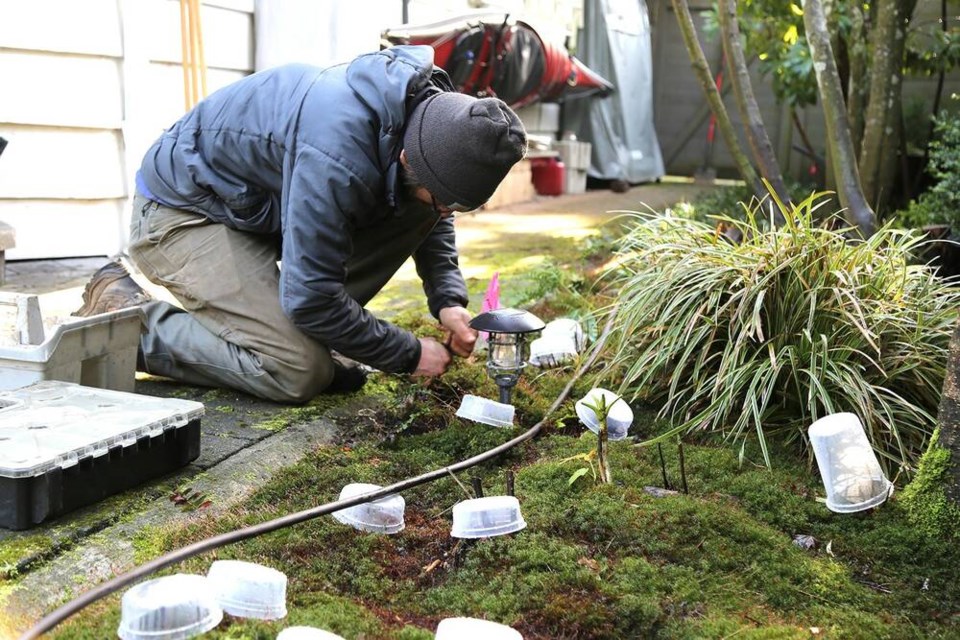One of the best investments we made last year was in natural resource management – that is, converting our circa 1992, multi-zone automatic sprinkler system to drip irrigation. Admittedly, the prospect of working backwards to turn 75-plus pop-up and rotary sprinkler heads into jumping off points for thousands of feet of dripline was daunting, particularly because their conversion points were long-buried 46 centimetres below our well-established garden.
I am nothing if not averse to shoddy craftsmanship, waste and needless mess, so I was very happy to meet Charles Coens, a like-minded, nature-loving irrigation specialist. He’s as passionate about designing and auditing functional, symmetrical and tidy drip irrigation and water-conservation systems, as I am about facilitating beautiful urban permaculture.
Charles – owner of Mamquam Irrigation – spent several cold and wet early spring days in our gardens last year, installing a Netafim drip irrigation system to help us to conserve water when irrigating existing gardens and raised vegetable beds. He also optimized the establishment of two new native ecosystems and one hügelkultur food forest installed where grassy boulevards once stood.
When Charles was done pinning the lines in place, drone photos of our beds looked like contour maps extracted from Google Earth Pro. Conspicuously missing from the landscape were clods of mud, trodden sod, driveway and patio pavers backfilled with soil, damaged plantings or virtually any other sign of the massive arterial bypass program deep below ground.
Almost one year later, having observed established and new gardens through a full cycle of seasons and multiple extreme hot and cold weather events, I can vouch for conversion as well as the hardware. Netafim irrigation systems originated in Israel’s Negev desert, where conservation regulations and climate extremes are far more challenging than ours.
I opted to bury the anchored drip lines just a few centimetres below the moss, compost and various groundcovers protecting the soil throughout our property. This took some time and required an extra measure of caution whenever transplanting and digging, but I love the result. And, because we opted for commercial-grade Netafim with its clog-free, flow rate-regulated emitters, I am confident of reliable, complication-free operation for many years to come.
I have installed other drip and soaker systems purchased from big box retailers, but they broke down and/or clogged within a few seasons, and defunct components were not recyclable. Above-ground mini Shrubblers and suspended driplines work impressively well for small patio and container gardens connecting to a standard water tap or garden hose. Lee Valley, Rona and Home Depot all offer brand name micro systems.
Professional design and installation of Netafim is an investment in environmental infrastructure, but we will certainly recoup costs over time. Of greater importance to me is knowing that we are helping plants and trees build climate-resilient root systems, eliminating water lost to over-spraying and evaporation, and maintaining a critical, moist, dark chocolate, cake-like living soil environment.
Only when soil maintains equilibrium, or homeostasis, can it make on-board and supplemented nutrients bio-available to plants, fungi, animals and ultimately humans. Dead and dry soil (dirt) is not necessarily devoid of nutrients, but without adequate supply and quality of moisture, alongside living organisms, fungi and microbiology, those nutrients remain locked and unavailable. Soil science is fascinatingly complex, but in theory and practice it is very simple: Observe and mimic thriving natural systems, and do no harm.
Editor’s note: The author receives no compensation or other benefit from any products or services mentioned in this article.
Laura Marie Neubert is a West Vancouver-based urban permaculture designer. Follow her on Instagram @upfrontandbeautiful, learn more about permaculture by visiting her Upfront & Beautiful website or email your questions to her here.
For a taste of permaculture, click on the YouTube link below:



.jpg;w=120;h=80;mode=crop)
